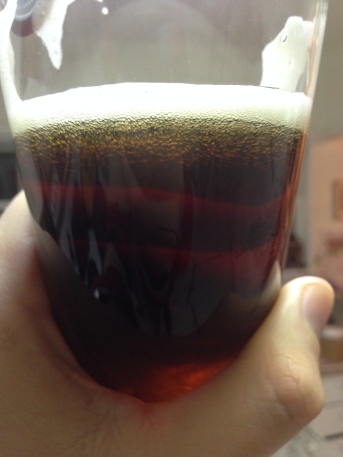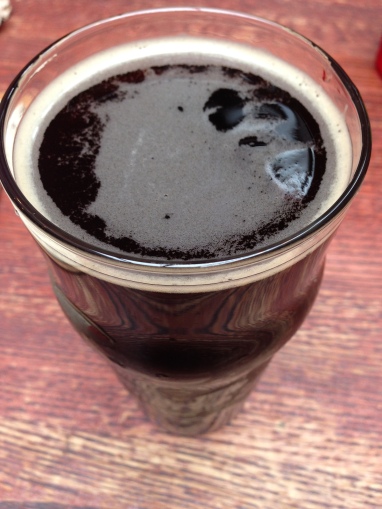It’s time we had a serious conversation about Altbier. This amber ale, hailing from Düsseldorf, deserves more respect. Even if you aren’t familiar with the style, Altbier has inspired craft beers you may already enjoy, like Alaskan Amber and Ninkasi’s SLEIGH’R. (Whatever you might think of Alaskan Amber, labeled as an “Alt Stye Ale,” it remains an excellent gateway drug for craft beer.)
But I really want to talk about the stronger variants of Altbier, known as Sticke and Doppelsticke. This rich, malty yet still bitter style is catching on in craft breweries.
But before we move on, you gotta learn to say it right. It’s not a “stick,” as in twig/branch. It’s like this: /SHTIK-uh/. Like a comedian’s “shtick.” Sorry, but I gotta use that German degree somehow. And it’s not like English doesn’t have those sounds. (Pretention: the feeling of tension that builds when someone is about to mispronounce something you care deeply about.)

Altbiers range from “light amber to deep copper” in color, but stickes can push up to just brown; they should be very clear, partly a product of a lagering period to cold condition and clarify the beer. The traditional serving glass is a tall, simple cylinder in which a thick head persists. Malty, biscuity aromas and subtly spicy hops are the dominant aromas, but if your sniffer is really good, you might also pick up traces of fruitiness from the Alt yeast. The strain I recently used (WLP 036) smelled like Rainier Cherries during fermentation!
The flavor is malty and slightly toasty, but the malt flavors are typically well-balanced by hop bitterness. However, the aroma and flavor of the hops are quite different from typical American IPAs. Instead of citrus, pine, or tropical fruit, the noble German hop flavor is more herbal, earthy, or even spicy, hop flavors I find more deferential to maltiness. Faint fruity fermentation flavors may emerge from the background, but nothing approaching the prominent esters of a Bavarian Weissbier or the fruitiness of some Belgian strains.
I first drank Altbier in Germany about 20 years ago. My memory of Alt’s flavor is that it had something reminiscent of leather. I got some weird looks for being a tender twenty-something drinking what some told me was an old man beer. At the time, knowing mostly pilsners, Weissbiers, and dunkels, I didn’t really know what to make of Altbier. The name, which means “old,” reinforced the notion that it was old or for old people. Now I think of that flavor as biscuits and belts. I assure you this is far better than it sounds. (Of course, they say the same about Wagner.)
Fast forward to a few years back: I came across Ninkasi’s SLEIGHR, which they labeled a “double alt.” I loved it. Essentially, Sleigh’r is a (doppel)sticke alt, though I didn’t realize it at the time.

Sticke first popped up on my radar in May 2017. I was at the Cascade Brewer’s Cup awards party, and the 3rd Place Best of Show went to the brewer of a Sticke Alt. Then, in August, I tasted Holy Mountain and E9’s collaboration Doppelsticke, called Donnyllama. Such malty goodness that it blew my mind.
Still, an Alt is fairly difficult style to find, especially Sticke strength. So I brewed one. I decided to go maltier than a typical Alt. I also wanted some hop flavors that were a bit more dynamic than Spalt, the German noble hop typically associated with Altbier. So I turned to Mt. Rainier, an unsung hop variety that has noble qualities, plus hints of citrus and licorice. I also threw in a variety called Crystal for some spiciness. The beer came out at about 6.3% alcohol, and the anise notes from the Mt. Rainiers came through without being overwhelming. It added some depth to flavor without screaming LICORICE!!!!! I’m very sad this beer is now gone, the last bottles shipped away to competition.
Though I have no more to share for now, Sticke Alts are popping up in more craft breweries: Dru Bru, Chuckanut, and Heater Allen. I predict that this style that will grow in popularity as a winter seasonal because it marries the maltiness that many people crave in the cool dark months with a firm bitterness that many craft beer drinkers demand in every beer.
So if you’re one of the 2-3 people remaining on earth who doesn’t need another IPA, give Altbier and its stronger variants a try.

Definitely a style that needs more love, and when I find one I have to buy it. I think I prefer the regular versions, but maybe it is because I haven’t had a good sticke in recent memory (mostly uerige imported stateside, so maybe not in the best shape).
I plan to homebrew one soon, and if I ever get around to having my own brewery, it’s one I plan to have as at least a seasonal if I can get it right.
LikeLiked by 1 person
Thanks for reading, Stephen. A Sticke is definitely a hard beer to find––that’s why I brewed my own! I’ve found mine to be a bit maltier than the recent ones I’ve encountered, but I’ve also realized that I like it that way, especially this time of year.
LikeLike